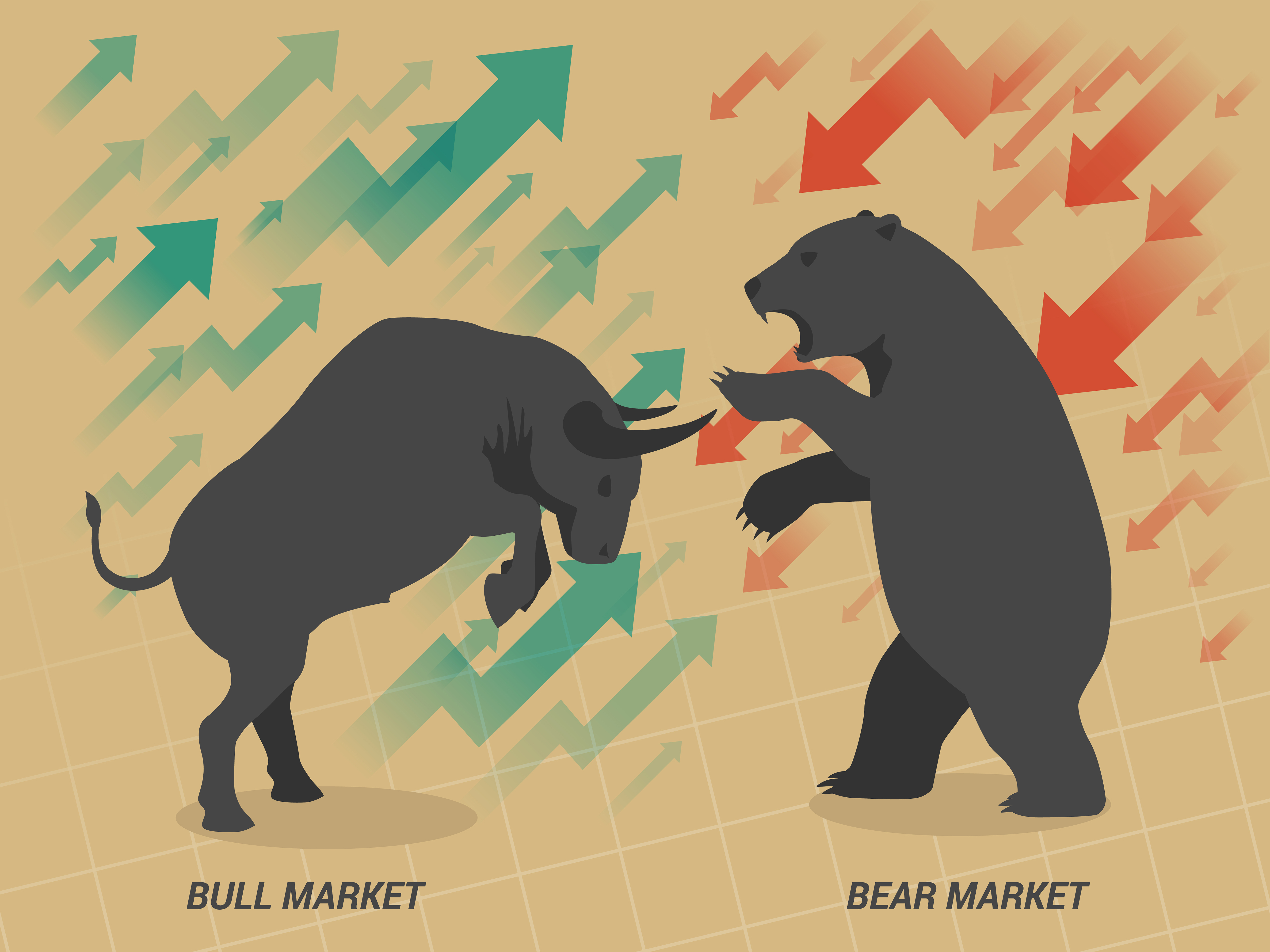The threat of a bear market never really goes away … After all, a bull market can’t last forever. What goes up will inevitably come down. So it’s important for traders to understand investing in a bear market.
Many traders consider bear markets a major bummer. Everything is down — securities, indexes, confidence … It’s enough to make any trader or investor want to hibernate.
Not so fast! If you can learn to shift your strategy, you can see that a bear market has plenty of opportunities. But it does require a mindset shift. You’ll need to accept and work with the market as it is, not as you want it to be.
Whether we’re entering a bear market now is still up for debate. But a bear market will come sooner or later. It’s an inevitable part of how the market works. So be smart and prepare now. Here are 5 tips for how to invest during a bear market.
What Is a Bear Market?
A bear market is the odd couple companion to a bull market. Where the bull market is characterized by optimism, high expectations, and a ‘buy, buy, buy’ attitude, a bear market is much more cautious.
Like a bear that would rather be hibernating, this market can be grumpy and vicious. Here are some characteristics of a bear market:
- Prices in the market drop — generally, that can mean at least a 20% decline from recent highs.
- An overall pessimistic attitude and low expectations for stock performance.
- Cautious, penny-pinching investors are reluctant to spend, which keeps the market in a state of decline.
How Frequent are Bear Markets?
Bear markets don’t happen every day, but they’re common enough…
According to Yardeni Research, which defines a bear market as a 20% decline, the S&P 500 has experienced bear market conditions about seven times in the past 50 years. There are also several instances of near-bear market conditions (for instance, a drop of 19.8%).
Of course, the exact number of bear markets over a specific time period is hard to track precisely … Different people define a bear market slightly differently.
What you should know is that bear markets are bound to happen from time to time. If you’re in it for the long haul, you’ll likely see more than one bear market in your trading career. Understanding investing strategies in a bear market can be key to helping you survive.
What Trading Techniques Work Best in a Bear Market?
In a bear market, the overall market trend is that prices are going down.
That can mean that certain stocks are available at a bargain, but investors are often unwilling to go long. That’s largely because it’s impossible to know how long the downward trend will last.
While it’s not impossible to go long and make successful trades, it’s important to be intelligent about what kinds of stocks you pick.
The sectors that succeed during a bear market can be very different than during a bull market. For example, necessary products and services will probably fare better than companies that offer luxury products.
Another trading technique that’s favored during a bear market? Short selling.
Short selling is a method of trading where you borrow shares of a stock from a broker and then sell them. Your expectation is that the price will continue to fall. You then buy back the shares at a lower price and profit from the price difference. Last, you return the borrowed shares to your broker and call it a day.
If short selling sounds risky, that’s because it is. If the price doesn’t go down, you’re still responsible for buying back the shares and returning them to your broker. You can really get in some hot water with this method if things don’t go according to plan. Let’s also clear up a common misconception: short selling isn’t illegal or unethical. It’s actually a long-standing method of investing … It’s been around since the days of legendary investor Jesse Livermore.
Be warned: Short selling can be a very risky strategy. It’s vital to conduct thorough technical analysis and fundamental research before entering a trade.
Current Market Fears
Fear sells, right? So you’ve probably seen fear-mongering headlines about an imminent market crash. The stock market news reads kind of like the tale of Chicken Little: “The market is falling! The market is falling!”
True: The Dow and the S&P are down. But does that mean a crash is on the horizon? Maybe, but not necessarily. After all, there are some extenuating circumstances at work in the market right now — at the top of the list is the U.S.-China trade war.
What’s the Skinny on All This Recession Talk?
Is there a chance of a market crash? Yes. But don’t try to guess these things.
In a recent SteadyTrade video, I talk about why I think it’s a foolish approach to be timid in the current market. It really can be an incredible market right now — if you educate yourself on how to navigate it. Why not take advantage while it lasts?
Yes, it’s worth considering things like the 10-year interest rate, the inverted yield curve, and earnings. But at the end of the day, the prices and charts are what really matter.
Don’t buy into the fear-spewing talking heads on TV. Do your own research. Look at what’s happening right now in the market.
Eventually crashes and corrections will occur. But focus on the here and now. Make trading plans based on what you see going on in the market today, and stay on top of the news to make the most informed trading decisions.
Remember this, too: there isn’t a clear-cut switch that tells you, “Bing! We’re in a bear market!”
Since the market is cyclical, these timelines can be impossible to predict. Sometimes, it’s only possible to tell that we’re in a bear or bull market once we’re already in it.
5 Tips for Investing in a Bear Market
Again, it’s not impossible to trade during a bear market. But you need to shift your mindset and approach the market intelligently. Here are 5 tips for investing in a bear market.
Have Patience
A bear market can be scary. It can feel like you’re in a free-falling elevator and don’t even know how many stories are in the building or what floor you started on.
So remember the adage that what goes up must come down … In the case of the stock market, what goes down will most likely go up again.
While not all stocks will survive a bear market, the overall downtrend will eventually reverse itself. So in a big-picture kind of way, patience is your biggest virtue in a bear market.
Here’s some good news: bear markets typically don’t last as long as bull markets. According to research, the average bear market since World War II has lasted about 14 months. Bull markets, on the other hand, typically last over four years.
Diversify Your Portfolio
During a bear market, you generally want to focus on survival and preservation. Diversification can help you keep your head above water.
Diversification is just a fancy word that means ‘don’t put all your eggs in one basket.’ The idea is that by investing in a variety of sectors or in a variety of different securities, you can have some investments that thrive when others are down.
Yes, during a bear market, the trend is downward. But not all stocks will go down at the same rate. It’s possible that some might even thrive. So, by having a portfolio that covers a few different sectors, you can mix your winners and losers to help reduce overall losses.
Now, within diversifying your portfolio, how can you stay savvy to the current market conditions and proactive in building your account?
One way is to focus on stocks that are less likely to drop in value. For instance, during a bear market, you might choose to focus on non-cyclical companies or companies that don’t careen downward in times of economic distress. Think essential products and services, like food staples, utilities, and healthcare — companies and sectors that could remain more solid.
Another method for investing in a bear market is to look for stocks that pay dividends. Even if the stock prices don’t go up, dividends can help sweeten the deal. These companies may be less volatile, but slow, steady returns can help when times are tough.
A bear market can also be a good time to explore different investment vehicles. For example, bond prices can move against the direction of stocks. They can be a great addition to your portfolio during a bear market.
Keep Your Focus on the Short Term
Trading is kind of like a game of chess. You need to always think two or three steps ahead … But if you lose sight of the here and now, it could be checkmate before you know it.
It’s impossible to know how long a downward trend will continue in the stock market. So it’s typically not wise to load up on shares of a particular stock during a bear market in anticipation of the trend reversing. Instead, continue to look at the market at large. But focus your actual trading plans on what’s happening right now.
For some people, that means short selling, which is typically not a long-term trading technique. That, plus the fact that prices are falling, can make it an alluring bear-market trading technique.
For others, a short-term focus means looking at different types of securities. Short-term bonds, for instance, can be more stable than stocks. That can be a way to minimize your exposure to stocks while the bears reign.
If you’re into options, another strategy is to buy short-term puts on major indices. However, not all brokers offer options trading. Be sure to check whether your broker offers options trading.
Keep an Eye on Market Signals
It’s always important to look to the market for signals as to its conditions or changing trends.
Here are some things to look at to help determine the waxing or waning of a bear market:
- Employment rates: When unemployment is up, a bear market is more likely. Low unemployment can be a sign that the economy is trending upward.
- Inverted yield curve: An inverted yield curve occurs when the interest rates on short-term bonds move higher than the rates paid by long-term bonds. This is a sign that people are concerned about the economy in the short term and more willing to go for a safer long-term option. It’s seen as a potential sign of a bear market.
- Changes in business profits: A consistent lowering of business profits across the board could be a sign of an oncoming bear market. On the other hand, higher profits could mean that we’re beginning to emerge from a bear market or that the economy is on a strong path forward.
- Gold prices: For new traders, this might be surprising … but check out gold prices. Often, gold trends very high during times of economic uncertainty.
- Fed funds rate: Changes in the fed funds rate can give an indication of the market’s direction. For instance, if the rates are suddenly and drastically lowered, many see it as a sign of a bear market.
Keep Some Cash on Hand
One of the more extreme ways that some traders will deal with a bear market is to take the fire-sale approach.
In this strategy, known as capitulation, you sell everything and either hold on to the cash or invest your account into more stable financial instruments. The idea is that you minimize losses during a potentially cataclysmic bear market.
The problem with this strategy? First, you don’t know how long a bear market will last. Second, it can keep you from benefitting from the upside, which usually will come.
Capitulation is probably a more extreme approach than I’d suggest.
That said, keeping some cash on hand isn’t a bad idea, especially in a bear market. That can mean maintaining a reserve or selling off what you see as definite losers to pad your account. It can be smart to have cash on hand to help keep your options open.
Conclusion
Few investors jump for joy at the prospect of a bear market. But just because the market is in decline doesn’t mean your trading career needs to hibernate.
By changing your strategy and putting some defense mechanisms in place, you can not only survive but maybe even get ahead in the dreaded bear market. There are always opportunities for savvy traders!
StocksToTrade
Navigating a bear market isn’t easy. You’ll need a powerful stock screener to help you evaluate stock charts and price action.
StocksToTrade can help take the heavy lifting out of the process of finding stocks to trade.
This powerful, trader-designed platform was created to help you find promising stocks. Here are some of its many features:
- A powerful stock screener that helps you perform scans based on criteria you set. You can filter by your favorite chart patterns, indicators, or fundamentals to find the stocks that fit your trading style.
- Awesome charting capabilities. You can look at technical indicators, alerts, price action, and news … all in one platform. Maintaining your watchlist has never been easier!
- Relevant news links. A news scanner gives you easy access to the latest headlines, SEC filings, and even social media buzz. An informed trader is an intelligent trader!
These are just a few of StocksToTrade’s many features. Wanna see for yourself? Try a 14-day trial of StocksToTrade for just $7! Check out the platform that so many top traders choose to use — StocksToTrade.
What do you think is on the market horizon and why? Are the bears really lurking or is FOMO taking over? Leave a comment and let me know!







